Have you ever thought about avoiding injuries in your everyday life? Injuries can occur unexpectedly in activities like sports, exercising, or even simple tasks. Here, we’ve got 15 tips to help you stay safe. These tips can lower your injury risks starting today. Curious about how to avoid injuries? Let’s get into it!
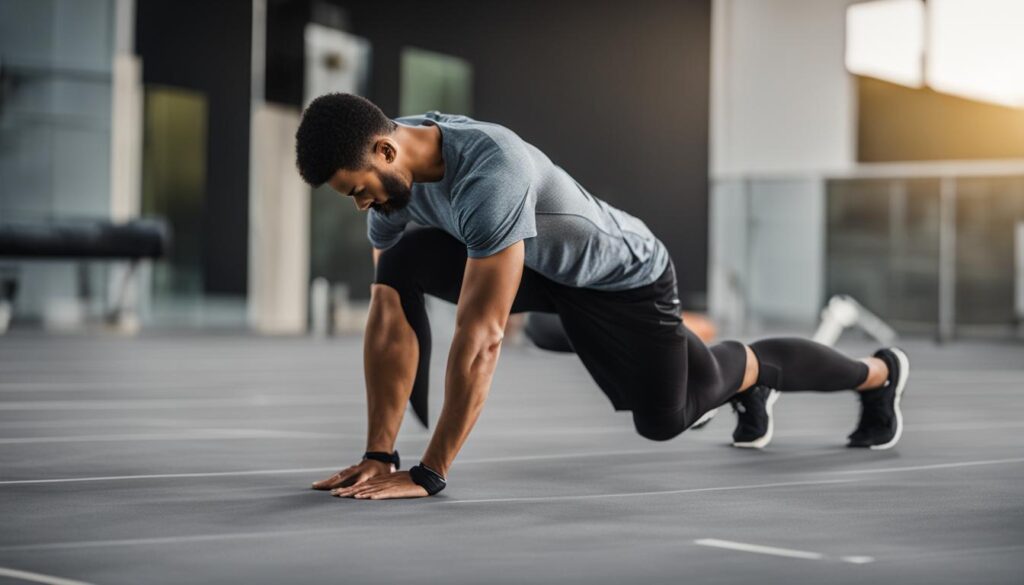
Key Takeaways:
- Wear appropriate protective gear for different activities.
- Encourage children to play a variety of age-appropriate sports to avoid overuse injuries.
- Take breaks and stay hydrated to prevent heat illness.
- Use proper technique and stop if an activity causes pain.
- Strengthen muscles and increase flexibility to reduce the risk of strains and sprains.
Wear Appropriate Protective Gear
Wearing the right protective gear is key to avoiding injuries in sports and activities. This gear greatly lowers the chance of getting hurt. It keeps you safe. Here are some must-have protective items:
- Pads (neck, shoulder, elbow, chest, knee, shin)
- Helmets
- Mouthguards
- Face guards
- Protective cups
- Eyewear
Make sure the gear fits right and suits the sport or activity. Gear that’s too big or small won’t protect well. For instance, a loose helmet can’t stop head injuries well. So, picking the right gear for each sport is crucial.
Though gear is key, it can’t stop all injuries. Yet, it really helps lessen the risk. Pads soften blows to areas like shoulders and knees. Helmets are a must for sports like biking, protecting the head. Mouthguards keep your mouth safe, and face guards your face from hits. Protective cups are important in sports like baseball for sensitive areas. Eyewear keeps your eyes safe from flying objects.
Always check your gear for damage or signs of wear. Gear that’s broken or old may not guard you well. Also, follow the care instructions from the maker to keep gear working right.
In the end, choosing and wearing the right protective gear is crucial for safety in sports and activities. It cuts down on injury risks. By picking suitable, well-fitting gear, you can play safely and with peace of mind.
Play a Variety of Age-Appropriate Sports
Doctors say playing various sports can help prevent injuries. By not focusing on just one sport, you avoid overuse injuries. This means you’re less likely to hurt specific muscles or joints.
It’s good for kids to try many sports. This helps them grow, get fit, and not get hurt as much. They’ll learn different skills and stay active in the best way.
Expert Tip: “Playing a range of sports reduces injury risk and boosts kids’ athletic skills and movement.” – Dr. Emily Johnson, Pediatric Sports Medicine Specialist
Benefits of Playing Different Sports
Playing various sports has many perks:
- **Reduced Overuse Injuries:** Different activities help avoid hurting the same muscles and joints too much.
- **Improved Physical Fitness:** Trying different sports works out various muscles, making you overall fitter.
- **Enhanced Motor Skills and Coordination:** Diverse sports fine-tune motor skills, coordination, and balance.
- **Mental and Psychological Development:** Facing new sports challenges boosts mental skills and adaptation.
Enjoying different sports makes for a balanced athletic life. It keeps injuries at bay and helps both your body and mind grow.
Measuring Success: A Comparative Analysis
| Sport Specialization | Playing Different Sports |
|---|---|
| Injury Risk | Reduced Risk |
| Increase the likelihood of overuse injuries due to repetitive motions and strain on specific areas of the body. | Provides a balanced physical load, reducing the risk of overuse injuries. |
| Physical Fitness | Improved Fitness |
| Tendency towards specific muscle groups becoming dominant while neglecting others. | Improves overall fitness by challenging different muscle groups. |
| Skill Development and Coordination | Enhanced Skills |
| Narrow focus on specific skills, limiting the development of well-rounded athletic abilities. | Refines motor skills, hand-eye coordination, and agility through exposure to different sports. |
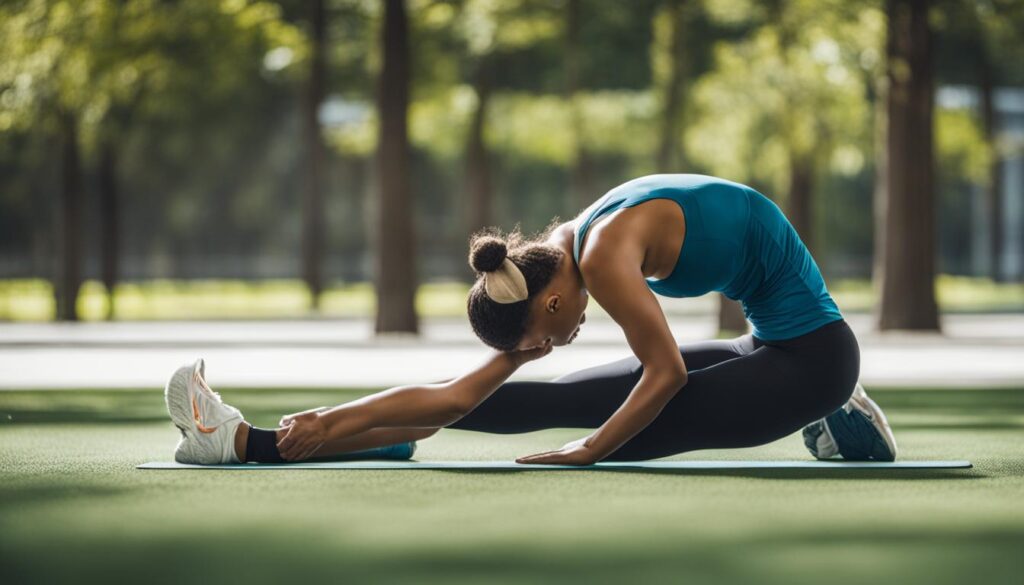
Take Breaks and Stay Hydrated
Rest periods and drinking enough water are key to avoiding injuries and staying at your best during sports. Taking breaks lets your body heal and stops you from pushing too hard. Meanwhile, being hydrated keeps your body temperature normal and prevents heat sickness.
It’s vital to plan for rest to let your body recover from being active. You should take a day off each week and a month off each year from training in a sport. This downtime lets your muscles and joints heal and grow stronger. It keeps you from getting hurt from doing too much.
Drinking fluids is essential, especially when you’re active. You should drink water before, during, and after exercise to stay hydrated. Water is usually the best choice. But for long or tough workouts, sports drinks can be good because they replace lost electrolytes.
Being aware of the weather is also important for planning your activities. When it’s very hot or humid, you might need to lessen or skip workouts to avoid heat sickness. Wearing light clothes and resting in the shade or cool places helps keep your body cool. This reduces the chance of getting hurt from the heat.
| Rest Periods and Hydration Guidelines: | Benefits: |
|---|---|
| Plan for at least one day off per week and one month off per year from training. | Reduces the risk of overuse injuries and allows the body to recover. |
| Drink plenty of fluids before, during, and after exercise or play. | Maintains proper hydration, supports body functions, and prevents heat illness. |
| Decrease or stop practices or competitions during high heat or humidity periods. | Reduces the risk of heat-related injuries. |
| Wear light clothing and take breaks in shaded or cool areas during hot weather. | Helps regulate body temperature and prevents overheating. |
By planning rest and keeping hydrated, you can avoid injuries and make sure your body is at peak performance. Always listen to what your body tells you and take breaks if you need them. Stay hydrated, take good care of yourself, and safely enjoy being active!

Use Proper Technique and Stop if It Hurts
When you’re active in sports, it’s vital to use the right technique. This goes for throwing a ball, swinging a bat, or any specific move. Doing it right can cut down injury risk and make you perform better.
Correct sports technique means moving your body the right way. It keeps the muscles and joints working well together. This lowers the chance of getting hurt.
Coaches are key in helping athletes use proper technique. They offer guidance and keep teaching the right form all season. This is important for every sport.
“Mastering basic skills is crucial for preventing injuries, ” says Coach Sarah. “Learning good habits early on helps avoid stress on the body.”
– Coach Sarah Smith, Head of Sports Training Program at XYZ Academy
It’s also key to pay attention to your body and recognize pain signals. Pain means something might be wrong. If you feel pain while doing an activity, you need to stop and see what’s up.
Ignoring pain can make an injury worse. It could even cause lasting damage. It’s smarter to rest and let your body heal than to push it too hard.
| Common Pain Signals | What to Do |
|---|---|
| Sharp or shooting pain | Stop what you’re doing right away and get medical help if needed |
| Persistent aches or soreness | Take a break and rest the sore spot. See a doctor if it doesn’t get better |
| Swelling or inflammation | Use the RICE method: Rest, Ice, Compression, Elevation |
Make sure to use proper technique and listen for pain signs. This will keep you safe and enjoying sports and physical activities.

Strengthen Muscles and Increase Flexibility
Conditioning exercises and stretching are essential for avoiding injuries in sports. These practices make your muscles stronger and more flexible. This lowers your chance of getting hurt.
Conditioning focuses on the muscles you use the most in your sport. You can do weights, resistance bands, or exercises like push-ups. Working on these muscles makes you stronger and lowers injury risk.
Mixing different conditioning workouts into your regime is great. Try adding squats, lunges, push-ups, and planks to your routine.
Stretching makes you more flexible and improves how you move. It loosens your muscles and tendons, which helps prevent muscle pulls. It’s key to stretch daily and not to the point of pain.
- Dynamic stretching: Start with dynamic stretches that move your body parts in their full range. Do leg swings, arm circles, and walking lunges.
- Static stretching: Stretch and hold it for 15-30 seconds, targeting big muscles like your legs and shoulders. Try standing hamstring stretches and seated butterfly.
By doing both conditioning and stretching, you can make a complete workout. This not only builds muscle but also cuts down on getting hurt.
Let’s dive into why conditioning and stretching are so important. Here’s a quick look:
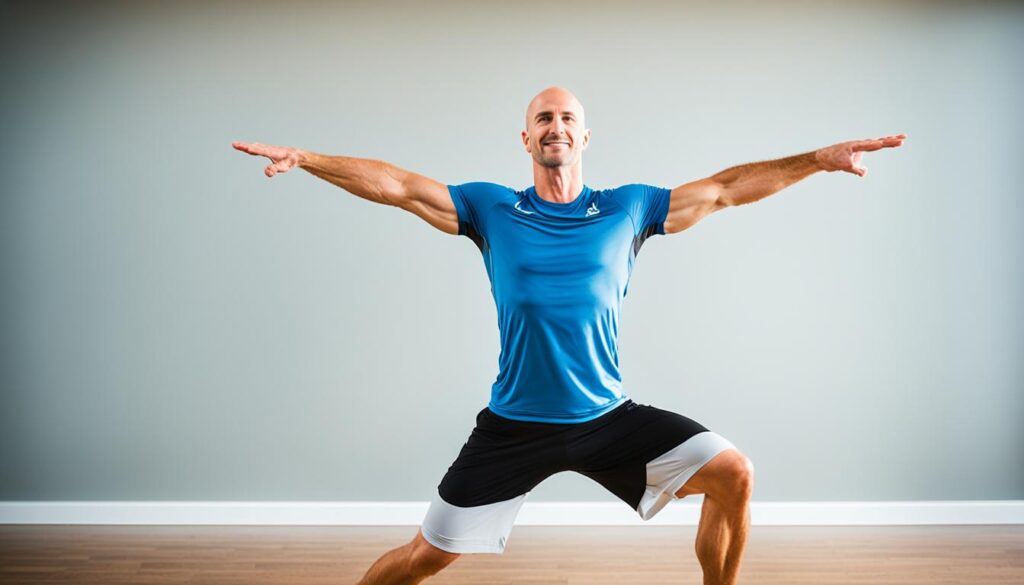
| Exercise Type | Benefits |
|---|---|
| Conditioning Exercises | – Strengthens muscles used during play – Improves overall performance – Reduces the risk of strains and sprains |
| Stretching for Flexibility | – Increases range of motion – Reduces muscle tension – Minimizes the risk of muscle strains |
Create a Fitness Plan and Alternate Muscle Groups
To avoid injuries, having a diverse fitness plan matters. It should have cardio, strength, and flexibility workouts. This mix helps lower injury risks and boosts overall health.
Switching up the muscles you work out is crucial. It stops muscles from getting too tired and lowers injury chances. This way, every muscle gets a fair chance to recover without being overused.
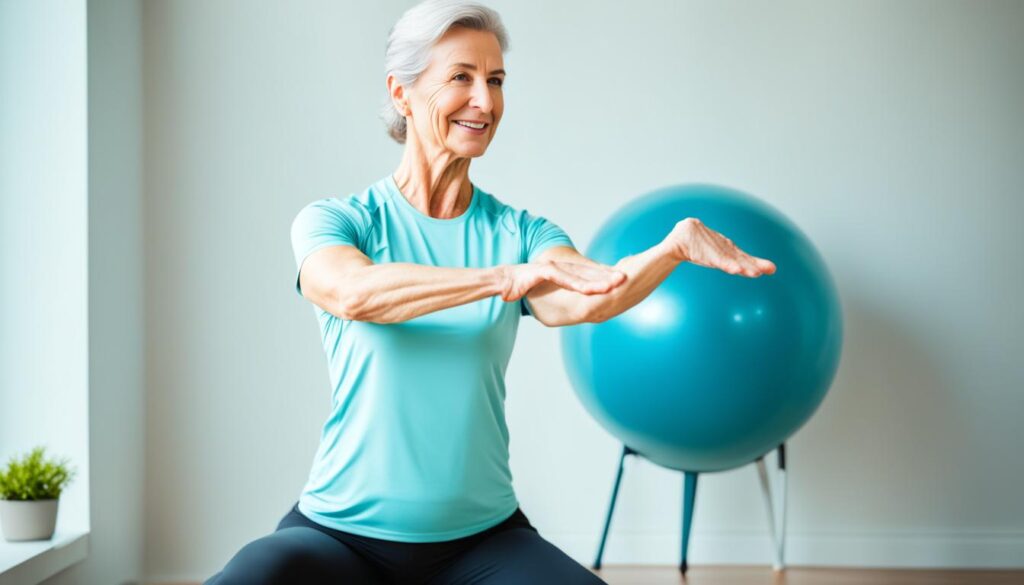
Don’t forget about rest days. They give your body the break it needs to heal. On these days, you can do some stretching or low-impact exercises. This keeps you active without overdoing it.
A balanced fitness plan includes different exercises and muscle rotation. It stops muscle exhaustion and cuts down on injury risks. Always tune into what your body needs. Change your plan to make sure all muscles get enough rest.
Use the Right Equipment and Learn Proper Methods
Preventing injuries in sports needs the right gear and proper technique. Getting the correct equipment and knowing how to use it lowers the risk of getting hurt.
Wearing the right gear protects you. For example, in contact sports, wearing helmets, pads, and mouthguards can prevent serious head and body injuries. Good shoes are also key for avoiding foot and ankle injuries.
But, having the right gear isn’t enough. You also need to know the right way to play. Correct form and technique cut down on injury risk. This is true whether you’re playing tennis, basketball, or lifting weights.
Coaches and trainers teach these vital techniques. They help with using the right body movements, standing properly, and moving safely. This guidance helps in making your sport or exercise routine safer and more effective.
“Having the right gear and knowing the right technique boosts your performance and keeps injuries away. Safety first, always. Make sure you’re well-informed and equipped to enjoy what you love doing safely.”
It’s not just about the gear; it’s about using it right and knowing its limits. Learn and practice with experts. This reduces risks linked to the wrong gear use or technique.
Recommended Sporting Gear
| Sport | Protective Gear |
|---|---|
| Soccer | Shin guards, cleats, goalie gloves |
| Football | Helmets, shoulder pads, mouthguards |
| Basketball | Protective eyewear, supportive shoes |
| Tennis | Rackets, tennis shoes, wristbands |
| Gymnastics | Leotards, grip gloves, wrist supports |
Choose the right protective gear for your sport and level. Ask experts or coaches to make sure you have what you need.
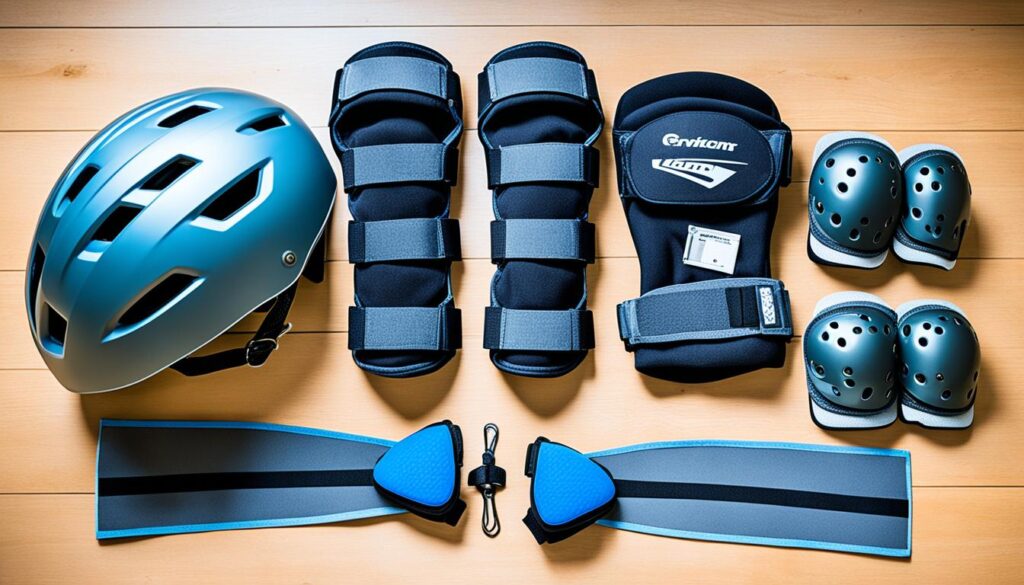
Rest and Rehabilitate as Needed
It’s crucial to rest when you feel tired or in pain. This helps prevent injuries. Avoid pushing through fatigue or ignoring injury signs. Taking breaks helps your body heal and lowers further damage risk.
Seek medical care if you get a sports injury. A healthcare professional will look at your injury and tell you what to do next. Following their rehab plan is key to safely getting back to activities and avoiding more injuries.
Getting back into physical activities after an injury requires patience. You must listen to your healthcare professional and take it slow. This approach builds strength, increases flexibility, and boosts your confidence in your abilities.
FAQ
How can I prevent common injuries in everyday life?
What protective gear should I wear to prevent injuries?
Why is it important to play a variety of age-appropriate sports?
How can taking breaks and staying hydrated prevent injuries?
Why is using proper technique important for injury prevention?
How can strengthening muscles and increasing flexibility help prevent injuries?
What should be included in a fitness plan for injury prevention?
How can using the right equipment and learning proper methods prevent injuries?
Why is resting and rehabilitating important for injury prevention?
Source Links
- https://www.healthychildren.org/English/health-issues/injuries-emergencies/sports-injuries/Pages/Sports-Injuries-Treatment.aspx
- https://www.urmc.rochester.edu/encyclopedia/content.aspx?contenttypeid=85&contentid=P00935
- https://www.betterhealth.vic.gov.au/health/healthyliving/child-safety-and-injury-prevention